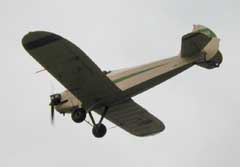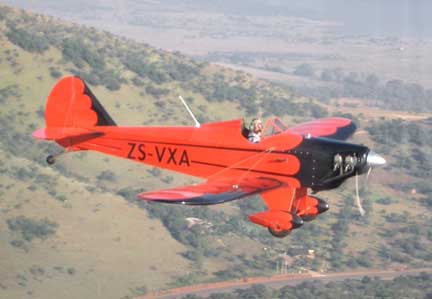 For one thing,
the Bernoulli vs. Newton argument isn't a dull squabble. It's cats
yowling bloody murder in a confessional; it's knife-wielding hyenas in
a portapotty.
For one thing,
the Bernoulli vs. Newton argument isn't a dull squabble. It's cats
yowling bloody murder in a confessional; it's knife-wielding hyenas in
a portapotty.
I'm an unusual Seattlite: I don't drink coffee.
But my wife does. Since I get up a bit earlier than her on the weekends, I usually make a trip to a nearby Starbucks to get her a wake-up latte. Mind you, the coffee shop *is* by the home drome....
Last weekend, I was coming out of the store when I heard it. A kind of muttered whisper, like a couple trying to have a private argument in a public place.
But this one...well, I knew who the couple were. It was Bernoulli and Newton, squabbling again. I walked out further from the building and watched over the roof. A few seconds later, a older Piper Cherokee sailed into view, on final for the airport just a quarter-mile away.
No true pilot can *not* watch an airplane in such circumstances. My head swiveled as I continued my slow walk to the car. I could imagine sitting in the pilot's seat, concentrating on the threshold ahead while terrain slid past in my peripheral vision. Hearing the dull hum of the wind pushing its way past formed aluminum and blown plexiglass, punctuated by the murmur of the idling Lycoming.
But I was ground-bound that moment, watching a more-fortunate man pass by. The hum and murmur dopplered overhead. The sound faded as the plane dipped behind the low buildings further on, where Newton eventually won the argument. As he always does. The aircraft sounds were gone, replaced by the background noise of urban existence.
As I climbed into the car, even that faded away. It reminded me of how isolated the pilot of a cabin-type airplane is. Gann called it "The Island in the Sky," but it doesn't really apply to Fly Baby pilots. We're awash in the ocean of air, not lying on a protected beach watching its fury. We experience flight in a more immediate, more intimate way.
 For one thing,
the Bernoulli vs. Newton argument isn't a dull squabble. It's cats
yowling bloody murder in a confessional; it's knife-wielding hyenas in
a portapotty.
For one thing,
the Bernoulli vs. Newton argument isn't a dull squabble. It's cats
yowling bloody murder in a confessional; it's knife-wielding hyenas in
a portapotty.
The main contributor is the landing wires...and who can blame them? They're the innocent bystander in this fight. They only support the wings when the airspeed is too slow to allow them to support themselves. Above 20 MPH or so, they're just along for the ride.
The cacophony isn't surprising. Within a couple feet of the pilot's ear are eight turnbuckle barrels (each with a center hole), eight turnbuckle eyes, eight wire thimbles, eight turnbuckle forks, eight clevis pins, and eight cotter pins, all exposed directly to the prop blast. Romantics describe the wind "singing in the wires". Being a dull ol' engineer, I hear no singing. It's a shriek, pure and simple. It's dull and fairly low-pitched at low speed, and high-pitched and truly screaming at cruise.
I once took a sound meter aloft. Chest high at cruise, it registered 109 dB. That's louder than a jackhammer, and almost as loud as a chainsaw. I rarely hear anything else, when I'm flying. Once, in formation with the Story Special, I heard a faint pop-pop-pop when he turned away, momentarily pointing his exhausts at me. Another time, I was turning final with the engine idling, and heard a rushing sound building in volume. I looked frantically around for a nearby airplane, only to discover the noise came from the train I was passing over.
Back in the N500F days (no radio), I flew the first couple of times with no hearing protection. Ringing ears convinced me to wear earplugs. Since Moonraker has a radio, I use a headset.
That, in itself, has caused a few hearing issues. I was once flying along, minding my own business, when I heard a tremendous POP! to the right. I jerked my head around, expecting to see trailing shards of wing. Nothing wrong. It had been the strap of my B-3 style flying jacket. A wayward breeze had flipped it upwards; the brass-capped end had tapped on the outside of the headset ear cup.
The playful breeze is another aspect closed-cabin pilots don't experience. As I mentioned in the scarves posting a couple of weeks back, the windshield blocks the cockpit from the direct blast, but the pilot is subject to sometimes-whimsical wafts of air. A fluttering of the scarf, the random shake of a sleeve. But a focused hurricane, anytime a map is unfolded.
And always...always...the touch on the unprotected skin.
This time of year, temperatures run in the mid-40s. Helmet, goggles, gloves, and scarf protect most of the epidermis, but there's always a cooling draft on the cheeks and the gap between the helmet and scarf. It's a bit uncomfortable for a bit, but one gets used to it. A guy once made a radio call, asking, "Aren't you cold?"... I responded, "Personal comfort is over-rated!"
As the months pass through spring, the waft on the exposed skin becomes barely noticeable. Just a flick of the fine hairs on the neck. But in the depth of summer heat, it morphs into a welcome friend. This time of year, I grin at the comments about cold and the shaking of heads as I taxi by. When the temperature goes into the nineties...well, I'm laughing out loud.
There they go, taxing along with their doors and canopies propped open, trying to deflect a little prop blast into their steaming cockpits. And there *I* go, with the collar of my shirt fluttering in the breeze, elbow jaunty on the cockpit rim. Years ago, I came out to the airport on a steaming hot day, and saw one of the other club members sitting in the idling N500F. He held his young daughter upright in the cockpit. She stood with her eyes shut, arms straight out the sides, dress rippling in the breeze from the mighty Continental.
Yes, my car is air-conditioned, and my wife forced us to add AC to the house (pretty rare, in the Northwest). But there's no cooling like the blast from Hurricane Continental and Typhoon Sensenich. And don't all those guys in the sweaty closed cabins just know it!
 And that brings
up the final big advantages Fly Baby drivers have: Closed cockpits
stink. They're flavored by a primordial effluvia of ratty plastic,
moldy carpets, sponged-up puke, leftover halitosis, and years of sweaty
pilots and passengers.
And that brings
up the final big advantages Fly Baby drivers have: Closed cockpits
stink. They're flavored by a primordial effluvia of ratty plastic,
moldy carpets, sponged-up puke, leftover halitosis, and years of sweaty
pilots and passengers.
Fly Baby cockpits smell like the breeze. No smells seem to stick, except perhaps a hint of varnish and a touch of avgas.
What's more...Fly Baby pilots get to smell the world as it floats by. The crisp dryness of winter, the green of spring. Flying through smoke from wood fires in an interesting experience. If you hadn't been paying attention, the sudden smell of burning timber gets the heart racing a bit...after all, you *are* flying a wooden airplane. It's like smelling BO in a crowded elevator. You're intrigued, but are praying that it ain't *you*.
One smell...heck, it brings a grin to my face, every time I catch it. Sometimes, when cutting the throttle during the turn from downwind to base, I catch a little waft of over-rich mixture from the exhaust. A combination of yaw during the turn, a bit of slipstream magic, but it's a quick momentary tang. N500F did it, and I was pleased to discover Moonraker does as well.
Yes, my plane is slow, uncomfortable to sit in for long periods, and
doesn't have four square yards of digital avionics. But the wide-open
vistas are unmatched by any closed-cockpit bird...and the input from the
other senses aren't bad, either.